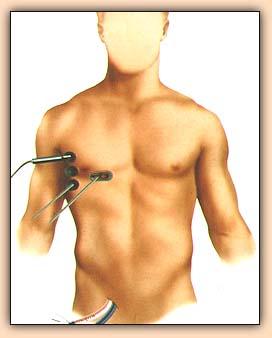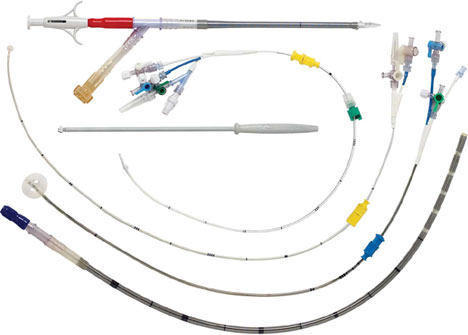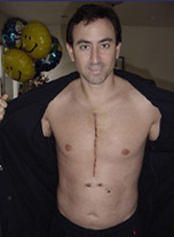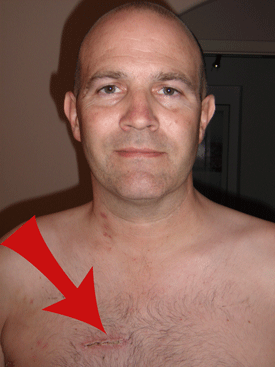“What About Port Access For Heart Valve Surgery?” Asks Taylor
By Adam Pick on October 31, 2009
I just received a great question from Taylor about heart valve replacement and heart valve repair options. Specifically, Taylor is curious to learn more about the Port Access System for the surgical treatment of aortic stenosis.
Taylor writes, “Hi Adam – I’m 62 years old and my cardiologist thinks I need heart valve replacement surgery due to stenosis in the aortic valve. The valve is narrow (.8 cm) and I’m starting to feel the symptoms – especially shortness of breath and fatigue. The docs have referenced the Port Access technique to replace the aortic valve. What do you know about the Port Access system? Thanks Taylor”

Diagram Of The Port Access Technique
Taylor raises an insightful question which focuses on the different options by which surgeons perform heart valve replacement and heart valve repair surgery.
My research suggests there are really three core categories for aortic valve replacement – median sternotomy (a cut through the breastbone), minimally invasive (robotics, mini-sternotomy) and catheter-based (no bone or sternum incisions). In my opinion, the Port Access System belongs in the minimally invasive category.
During an aortic valve replacement using the Port Access technique, the following steps occur:
- The patient goes on the heart-lung machine. You will have your blood flow diverted from its path through the heart to an artificial heart-lung machine which will continue to provide your body with the oxygenated blood it needs. A small cut will be made in your thigh through which the tube will be fed which will put you on the heart-lung machine (see diagram above).
- Another incision will be made in your neck. This is where the surgeon will put a tube into your blood vessel and follow it to the heart. Through this tube, drugs to stop your heart will be given.
- To allow the doctor to see and to operate, surgical tools and a camera are fed through a cut under your armpit.
- The surgeon removes the malfunctioning valve. The surgeon will then insert and attach either a mechanical or a biological valve replacement. If you are given a mechanical valve, you will need to take medications (e.g. Coumadin) for the rest of your life to prevent blood clots around the new valve.

Tools Used In The Port Access System
Below you will see two pictures which illustrate the different incision sizes between (i) a Port Access approach using a right mini-thoracotomy and (ii) a median sternotomy. The first picture shows a patient’s chest scar after a median sternotomy. FYI, that’s me one week after surgery.

The second picture shows a patient, Jim Engelmann, after an aortic valve replacement using the Port Access system.

Jim’s Mini-Thoracotomy Scar After Valve Replacement
So you know, the Port Access approach can also be used to treat the mitral valve. In fact, Edwards Lifesciences, the device manufacturer of the Port Access system, recently issued clinical results which showed that:
- Patients undergoing mitral valve repair with the Port Access System had hospital stays approximately 1.5 days less than sternotomy patients;
- The number of patients requiring post-operative ventilation was reduced from 75.6 percent in the sternotomy group to 50.3 percent in the Port Access group.
Although the information provided above is very encouraging, please, please, please remember that each patient case is unique. You should discuss, at length, with your surgeon if the Port Access system via right mini-thoracotomy is appropriate for you.
I hope this helps you learn more about the Port Access system for heart valve replacement and heart valve repair.
Keep on tickin!
Adam
|
Don Henry says on October 31st, 2009 at 2:34 pm |
|
This may be an option for first AVR surgery and hopefully this will be the case for Taylor. I attended a seminar by Dr Marc Katz, heart surgeon in Richmond, Va and he does the robotic non-invasive DaVinci technique for mitral valve replacement, but has not done it for AVR. Dr Jamie Brown at the U. of Maryland has performed this type technique with the aorta valve, so google Dr Brown and you can read about it. I do know that this port access surgery cannot be performed on re-do operation, which is my case. I had AVR in Feb 2000 at age 55 and I will be 65 in March 2010 and will undergo anothr AVR and I’m thinking about having it done at the Cleveland Clinic by Dr Gillinov, the surgeon , who operated on Robin Williams. My decision is mechanical or tissue. I am curious as to which valve Taylor will get. Chances are if you live 10 to 15 years after your first AVR you will need another surgery. Don |
 |
|
Wilmer Brown says on October 31st, 2009 at 2:43 pm |
|
I think I would rather have it done the old fashion way, where they can see and feel without camera’s and probes. The zipper goes away after awhile |
 |
|
Steve McDonald says on October 31st, 2009 at 5:44 pm |
|
Could this procedure be done with radiation damaged AV? I’M secheduled fpr surgery 11/25, my valve is .76 cm My surgeon kind of scared me with the term ” sudden death” which means at this level of stenosis the big one can happen at any time. It’s unpredictable. I have to agree with Wilmer, I think if there is radiation damage they are going to ant to have a nice big opening to work. Anyone have this level for stenosis and how long before you had surgery? I may call Mayo up on Monday 11/2 and see if I can bump up the date, he put a bit of a scare in me with the sudden death thing. |
 |
|
Kerrigan says on November 2nd, 2009 at 11:19 am |
|
The advice I received was “give the surgeon the room he needs to do it” due to the ascending aorta section which also needed to be replaced. With the large opening the surgeon could then see and fix anything else involved. Each case must be treated individually is the best advice I’ve received. |
 |
|
Rebecca says on November 3rd, 2009 at 1:27 pm |
|
I agree with Kerrigan. I had my aortic valve replaced on October 14 and when I asked my surgeon about a minimally invasive approach (which I was not a candidate for because this is my second operation) he said “Everyone wants me to work a miracle in the area the size of a quarter.” He did a fantastic job and I had the surgery done the “old fashioned way” I wouldn’t go back and change a thing. |
 |
|
Don Henry says on November 6th, 2009 at 2:00 pm |
|
To Rebecca: You said this was your second surgery. Can I ask your age at the time of your first AVR and your age now ? And what type of valves did you receive? As you may have read on this blog I am facing my second surgery in the very near future and I am 65 years old. I had a Carpentier Edwards Bovine tissue valve when I was 55, so it lasted 10 years. I surely don’t want to have to have 3 surgeries, so have to decide whcih valve to get ( tissue or mechanical) Thanks– Don Henry |
 |
|
Rebecca says on November 6th, 2009 at 2:23 pm |
|
Don Henry I am 35 years old…had aortic valve repair as a child when I was 8 (27 years ago). I decided to have a medtronic bovine valve as my replacement based on the fact that I didn’t want to be on coumadin for the rest of my life. My surgeon felt that I would get 15-20 years out of this valve and I know I will need another operation in my lifetime. Don’t know what options will be available to me then, but I will still be young at 55 when I have to make this choice again. Who knows how things will progress? Blessings to you as you make this decision – I am comfortable with mine and know you will come to the best decision for you. |
 |
|
betsy knight says on October 5th, 2015 at 10:10 am |
|
I’m between a rock and a hard place. I’m 49 years old and made AV replacement with a mechanical valve in 2010. Situation I’m in now is I had a stroke a week ago due to clots on the valve. With that being said, the valve needs to be replaced also bipass surgery. The thing is I’m had radiation therapy for Hodgekin’s Lymphoma in my teens. I know it’s extremely risky. What are my other options. I’m desperate for answers. |
 |













